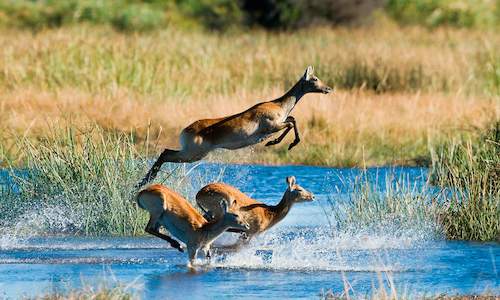
Spring
September / October: The arrival of springtime is confirmed when the migrant bird species begin appearing. Yellow-billed kites and carmine bee-eaters are usually the first to arrive, and woodland kingfishers the last. This will often coincide with the first light rains, sometime in September.- The annual catfish runs are reaching their peak in the Panhandle now, the tiger fishing is at its best.
- The Kalahari Summer Festival, an annual charitable music event that celebrates the imminent arrival of summer, is held during September in Gaborone.
- Independence Day (Botswana Day) is celebrated on 30 September.
- The October Beer Festival is held annually at the Grand Palm Hotel in Gaborone.
- Planting season: In preparation for the forthcoming rains, the planting season is in full swing.
- Most of the acacia trees are in bloom, and the baobab, sausage tree and apple leaf are all beginning to flower.
- Arrival of heavy rains, usually by late October, has the pans filling up with water, which allows the elephants to begin their migration away from the Linyanti and Chobe river systems.

Wherever you may be in Botswana, afternoon thunderstorms are an almost daily occurrence during summer.
Summer
November to February With the floodplains sprouting fresh grass cover, the first ungulate calves begin dropping in November, and by mid-December the calving season for Wildebeest, Impala, Tsessebe and warthog is over.- The water levels are at their lowest in the Panhandle now, heralding the end of the catfish runs.
- By early December the rains have soaked the ground, providing perfect conditions for the release of reproductive termites from their natal mounds. Releases may carry on throughout December.
- Towards the end of December, the first flood waters of the Okavango River arrive in the far northern regions of the Panhandle.
- Having completed their breeding, the African skimmers will leave the Panhandle region before the new waters begin covering the sandbars on which they nest.
- Thousands of zebra and wildebeest begin their mini-migrations in the Makgadikgadi, Linyanti and Savuti regions.
- The sour plum, African mangosteen and marula trees are fruiting in profusion now.

During the summer months the quieter backwaters of the Okavango are filled with colour when the waterlilies, (Nymphaea nouchali) come into bloom.
Autumn
March / April Two months or so after first flowing into Botswana, the flood waters reach the upper regions of the Okavango Delta.- The last of the heavy rains are likely to fall during March.
- Maun hosts the official opening of the photographic tourist season.
- The Maitisong Festival, Botswana's largest arts and dance festival, is held annually in the last week of March or the first week of April in Gaborone.
- Zebra and wildebeest begin their return migration towards the regions where water will be available during winter.
- At the start of April, the onset of lower temperatures, the migrant bird species begin leaving for their northern range. By late April, all will have left.
- The best bream fishing in the Panhandle begins during April, when the flood waters have settled somewhat.
- Throughout the country the harvest season is coming to an end.
- With the drying of the pans, the elephants are beginning to head back to the Linyanti and Chobe river systems.

Photographer's dream: autumn sunsets in the Okavango Delta.
Winter
May to August By mid-winter the flood waters have passed the full length of the Okavango Delta - usually reaching Maun some time towards the end of June.- The country celebrates its first President on 1 July, Sir Seretse Khama Day.
- Wild dogs den during June and July, with their pups due out by early August.
- The Ghanzi Agricultural Show is held annually in August.
- The Desert 1 000, a popular 4x4 off-road rally that starts from Gaborone and covers 1 000 kilometres across the southern Kalahari, is held annually over winter.
- D'Kar is a small place, and the Kuru Traditional Dance and Music Festival, which takes place here in August, it is annual.
- Gaborone plays host to the Trade Exhibition, a showcase of the country's trade, industry and agriculture sectors every year during August.

Mopane trees lose their leaves at the tail end of winter. Roan antelope roam the forests seeking out the last of the nutritious leaves, which will be replaced with young shoots once the first rains fall.

 Year round, you'll find something remarkable to do and experience in this land of contrasts. Each season in Botswana has its attractions...
Year round, you'll find something remarkable to do and experience in this land of contrasts. Each season in Botswana has its attractions...